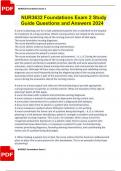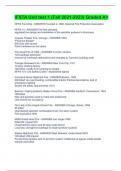NUR3632 Foundations Exam 2
NUR3632 Foundations Exam 2 Study
Guide Questions and Answers 2024
A nurse is planning care for a male adolescent patient who is admitted to the hospital
for treatment of a drug overdose. Which nursing actions are related to the outcome
identification and planning step of the nursing process? Select all that apply.
The nurse formulates nursing diagnoses.
The nurse identifies expected patient outcomes.
The nurse selects evidence-based nursing interventions.
The nurse explains the nursing care plan to the patient.
The nurse assesses the patient's mental status.
The nurse evaluates the patient's outcome achievement. - b, c, d. During the outcome
identification and planning step of the nursing process, the nurse works in partnership
with the patient and family to establish priorities, identify and write expected patient
outcomes, select evidence-based nursing interventions, and communicate the plan of
nursing care. Although all these steps may overlap, formulating and validating nursing
diagnoses occurs most frequently during the diagnosing step of the nursing process.
Assessing mental status is part of the assessment step, and evaluating patient outcomes
occurs during the evaluation step of the nursing process.
A nurse on a busy surgical unit relies on informal planning to provide appropriate
nursing responses to patients in a timely manner. What are examples of this type of
planning? Select all that apply.
A nurse sits down with a patient and prioritizes existing diagnoses.
A nurse assesses a woman for postpartum depression during routine care.
A nurse plans interventions for a patient who is diagnosed with epilepsy.
A busy nurse takes time to speak to a patient who received bad news.
A nurse reassesses a patient whose PRN pain medication is not working.
A nurse coordinates the home care of a patient being discharged. - b, d, e. Informal
planning is a link between identifying a patient's strength or problem and providing an
appropriate nursing response. This occurs, for example, when a busy nurse first
recognizes postpartum depression in a patient, takes time to assess a patient who
received bad news about tests, or reassesses a patient for pain. Formal planning
involves prioritizing diagnoses, formally planning interventions, and coordinating the
home care of a patient being discharged.
3. When helping a patient turn in bed, the nurse notices that his heels are reddened and
plans to place him on precautions for skin breakdown. This is an example of what type
of planning?
NUR3632 Foundations Exam 2
, NUR3632 Foundations Exam 2
Initial planning
Standardized planning
Ongoing planning
Discharge planning - c. Ongoing planning is problem oriented and has as its purpose
keeping the plan up to date as new actual or potential problems are identified. Initial
planning addresses each problem listed in the prioritized nursing diagnoses and
identifies appropriate patient goals and the related nursing care. Standardized care
plans are prepared plans of care that identify the nursing diagnoses, outcomes, and
related nursing interventions common to a specific population or health problem.
During discharge planning, the nurse uses teaching and counseling skills effectively to
help the patient and family develop sufficient knowledge of the health problem and the
therapeutic regimen to carry out necessary self-care behaviors competently at home.
. A nurse is prioritizing the following patient diagnoses according to Maslow's hierarchy
of human needs:
(1) Disturbed Body Image
(2) Ineffective Airway Clearance
(3) Spiritual Distress
(4) Impaired Social Interaction
Which answer choice below lists the problems in order of highest priority to lowest
priority based on Maslow's model?
2, 4, 1, 3
3, 1, 4, 2
2, 4, 3, 1
3, 2, 4, 1 - a. 2, 4, 1, 3. Because basic needs must be met before a person can focus on
higher ones, patient needs may be prioritized according to Maslow's hierarchy: (1)
physiologic needs, (2) safety needs, (3) love and belonging needs, (4) self-esteem needs,
and (5) self-actualization needs. #2 is an example of a physiologic need, #4 is an example
of a love and belonging need, #1 is an example of a self-esteem need, and #3 is an
example of a self-actualization need.
. A nurse is using critical pathway methodology for choosing interventions for a patient
who is receiving chemotherapy for breast cancer. Which nursing actions are
characteristics of this system being used when planning care? Select all that apply.
The nurse uses a minimal practice standard and is able to alter care to meet the
patient's individual needs.
The nurse uses a binary decision tree for stepwise assessment and intervention.
The nurse is able to measure the cause-and-effect relationship between pathway and
patient outcomes.
NUR3632 Foundations Exam 2
, NUR3632 Foundations Exam 2
The nurse uses broad, research-based practice recommendations that may or may
not have been tested in clinical practice.
The nurse uses preprinted provider orders used to expedite the order process after a
practice standard has been validated through research.
The nurse uses a decision tree that provides intense specificity and no provider
flexibility. - a, c. A critical pathway represents a sequential, interdisciplinary, minimal
practice standard for a specific patient population that provides flexibility to alter care
to meet individualized patient needs. It also offers the ability to measure a cause-and-
effect relationship between pathway and patient outcomes. An algorithm is a binary
decision tree that guides stepwise assessment and intervention with intense specificity
and no provider flexibility. Guidelines are broad, research-based practice
recommendations that may or may not have been tested in clinical practice, and an
order set is a preprinted provider order used to expedite the order process after a
practice standard has been validated through analytical research.
A nurse is identifying outcomes for a patient who has a leg ulcer related to diabetes. An
example of an affective outcome for this patient is:
Within 1 day after teaching, the patient will list three benefits of continuing to apply
moist compresses to leg ulcer after discharge.
By 6/12/15, the patient will correctly demonstrate application of wet-to-dry dressing on
leg ulcer.
By 6/19/15, the patient's ulcer will begin to show signs of healing (e.g., size shrinks from
3″ to 2.5″).
By 6/12/15, the patient will verbalize valuing health sufficiently to practice new health
behaviors to prevent recurrence of leg ulcer. - d. Affective outcomes describe changes in
patient values, beliefs, and attitudes. Cognitive outcomes (a) describe increases in
patient knowledge or intellectual behaviors; psychomotor outcomes (b) describe the
patient's achievement of new skills. c is an outcome describing a physical change in the
patient.
A nurse is preparing a clinical outcome for a 32-year-old female runner who is
recovering from a stroke that caused right-sided paresis. An example of this type of
outcome is:
After receiving 3 weeks of physical therapy, patient will demonstrate improved
movement on the right side of her body.
By 8/15/15, patient will be able to use right arm to dress, comb hair, and feed herself.
Following physical therapy, patient will begin to gradually participate in walking/running
events.
By 8/15/15, patient will verbalize feeling sufficiently prepared to participate in running
events. - a. Clinical outcomes describe the expected status of health issues at certain
NUR3632 Foundations Exam 2
, NUR3632 Foundations Exam 2
points in time, after treatment is complete. Functional outcomes (b) describe the
person's ability to function in relation to the desired usual activities. Quality-of-life
outcomes (c) focus on key factors that affect someone's ability to enjoy life and achieve
personal goals. Affective outcomes (d) describe changes in patient values, beliefs, and
attitudes.
A nurse is caring for an elderly male patient who is receiving fluids for dehydration.
Which outcome for this patient is correctly written?
Offer the patient 60 mL fluid every 2 hours while awake.
During the next 24-hour period, the patient's fluid intake will total at least 2,000 mL.
Teach the patient the importance of drinking enough fluids to prevent dehydration by
1/15/15
At the next visit, 12/23/15, the patient will know that he should drink at least 3 liters of
water per day. - b. The outcomes in a and c make the error of expressing the patient
goal as a nursing intervention. Incorrect: "Offer the patient 60 mL fluid every 2 hours
while awake." Correct: "The patient will drink 60 mL fluid every 2 hours while awake,
beginning 1/3/15." The outcome in d makes the error of using verbs that are not
observable and measurable. Verbs to be avoided when writing goals include "know,"
"understand," "learn," and "become aware."
A nurse is collecting more patient data to confirm a diagnosis of emphysema for a 68-
year-old male patient. What type of diagnosis does this intervention seek to confirm?
Actual
Possible
Risk
Collaborative - b. An intervention for a possible diagnosis is to collect more patient data
to confirm or rule out the problem. An intervention for an actual diagnosis is to reduce
or eliminate contributing factors to the diagnosis. Interventions for a risk diagnosis focus
on reducing or eliminating risk factors, and interventions for collaborative problems
focus on monitoring for changes in status and managing these changes with nurse- and
physician-prescribed interventions.
A nurse is caring for a patient who is diagnosed with congestive heart failure. Which
statement below is not an example of a well-stated nursing intervention?
Offer patient 60 mL water or juice (prefers orange or cranberry juice) every 2 hours
while awake for a total minimum PO intake of 500 mL.
Teach patient the necessity of carefully monitoring fluid intake and output; remind
patient each shift to mark off fluid intake on record at bedside.
Walk with patient to bathroom for toileting every 2 hours (on even hours) while patient
is awake.
NUR3632 Foundations Exam 2





